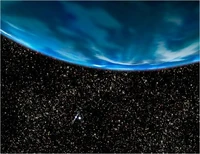
PSR B1620-26b (Methuselah), created by an artist
Super-Jupiter, also known as superjovian planet or methuselian planet, is a classification of planet with mass ranging from 2 to 13 Jupiter masses or 635.6 to 4131.8 Earth masses. Above 13 MJ, the nonplanetary object class is brown dwarf or hyper-Jupiter. Hence it is the most massive mass class of planet, super-Jupiter is rated M-Class I and has the symbol Ja.
Characteristics
Size
Despite all super-Jupiters are more massive than Jupiter, the most massive planet in our solar system, some of these are smaller than Jupiter because of their stronger gravity, hence stronger gravitational contraction. Gravitational contraction occurs when the planet's strong gravity pulls the surface inwards, making the planet smaller. After their formation, super-Jupiters tend to have radii 1.5 to 2 RJ, depending on their mass with more massive super-Jupiters tend to be larger. About five billion years after their formation, more massive super-Jupiters tend to have smaller radii than lower mass super-Jupiters, because more massive planets shrink faster than lower mass planets, thus strengthening their gravity which in turn shrink even faster. There are about two-fifths of all super-Jupiters that are smaller than Jupiter while others are the size of Jupiter or slightly larger, but some lower mass hot super-Jupiters are considerably larger due to the bloating of the outer layers of gas from the heat of the star. The gravity of super-Jupiters compress gases so much that some of those planets are denser than Earth, the densest planet in our solar system. The density of some high-mass super-Jupiters can approach 20 g/cm3, nearly four times denser than Earth.
Interior
Super-Jupiters are gaseous with no solid surface, but they have rock/iron cores surrounded by three layers of mantle. Super-Jupiters have tremendous pressures in their interiors even greater than Jupiter's because of their stronger gravities and higher densities. There is a supercritical fluid (gas and liquid phases merged) hydrogen-helium mixture in the upper mantle or the lower atmosphere, liquid metallic H-He in the middle mantle, and solid metallic H-He in the lower mantle. Pressure gets greater as we go deeper, so lower mantle exerts greater pressure than upper mantle, that's why hydrogen-helium mixture gets more compact and more metallic as we go deeper.
Thermodynamics and storms
Those planets tend to emit more heat from their interiors than Jupiter owing to stronger gravity. More heat emission means more activities! So super-Jupiters tend to have greater atmospheric activities such as more violent storms and stronger winds than Jupiter. The storms get more violent and wind gets stronger over millions of year as planets continue to emit more heat owing to strengthening gravitational contraction caused by shrinkage of the planets.
Abundance
It is estimated that there are 46 billion super-Jupiters in our galaxy alone, making it the least abundant mass class of planet. This corresponds that 56‰ of all 820 billion planets in our galaxy are super-Jupiters.
Known super-Jupiters
There are no super-Jupiters in our solar system. But Super-Jupiter is the most common class of known exoplanets because those planets are easiest to detect due to their high masses. More than 300 such planets are identified as of 2015. Notable examples are PSR B1620-26 b (Methuselah), which is the third oldest known planet at 12.7 billion years old and was the first super-Jupiter identified, HD 80606 b (Niobe) which has the most eccentric orbit of any known planets (e=0.93366), 2M1207b (Lerna), which orbits the brown dwarf, Fomalhaut b (Illion), and Kappa Andromedae b (Ligdus). This planetary mass class contains all of the densest planets in our galaxy, despite they are all gaseous. The densest known planet is HD 33473 Ab (Liberatilus). This planet is speculated to be 12.3 times more massive than Jupiter but it is just 57% the size of Jupiter, resulting in the planet's density of 86.4 g/cm3, nearly four times denser than the densest known naturally-occurring element osmium and nearly twice the density of keplerium, the densest element of the 172-element periodic table.
Related links
- Super-Jupiter — article about this planetary class on Wikipedia
| ||||||||||||||